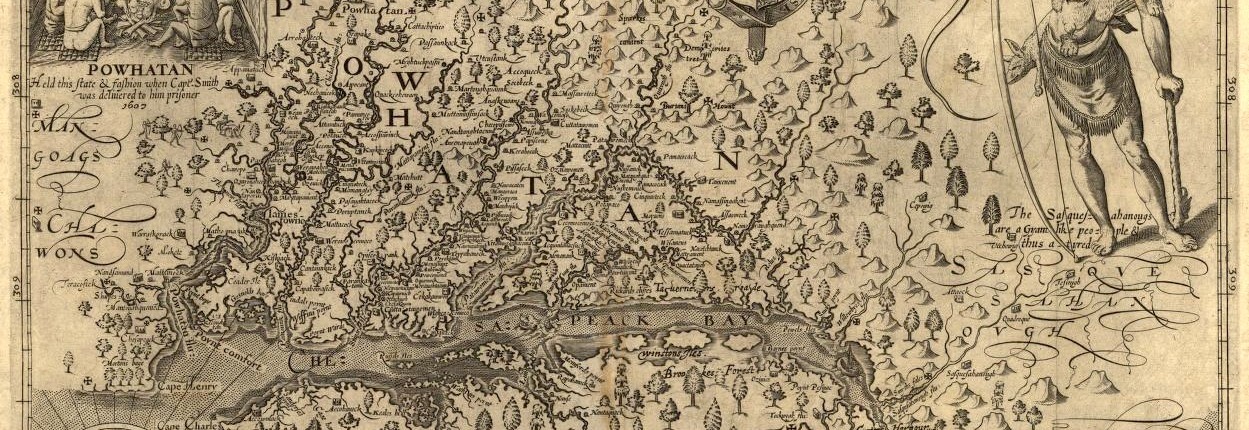Source 2.01: Smith, John, and William Hole. Virginia. [London, 1624] Map. Retrieved from the Library of Congress.
This map is already part of most teachers’ document repertoire, but just in case it is not, here is a copy. It would benefit particularly from being enlarged. Here is some background on Smith and this map.
Source 2.02: Fleet, Henry. “Fleet’s Journal of a Voyage in Ship Warwick.” The Founders of Maryland as Portrayed in Manuscripts, Provincial Records and Early Documents. Ed. Edward D. Neill. Albany: Joel Munsell, 1876. 19-37. Print.
Henry Fleet was one of the early Virginia (or perhaps Maryland) fur traders. He was captured by Nacostine Indians in the D.C. area in 1622 and held captive for five years. These excerpts from his journal document great examples of political and economic relationships between London, the colonies, English settlers, and different groups of Indians. Consider using each page depending on what a teacher might want to get out of the journal and what time is allowed. Here is narrative account of Fleets journal to understand the bigger picture.
Page 1 – The 4th of July 1631
- Trade routes between London, New England, and the Chesapeake Bay
- Demand in Europe driving economic behavior of Indians and traders to supply beaver in America
- The influence of geography
Page 2 – Monday, the 21st of May [1632],
- Competition in the beaver trade
- Relationships among the different groups of English and Indians
- Contrast of a frontier economy versus the plantation economy
Page 3 – On Monday, the 25th of June
- A description of the Arlington shore
- Intratribal conflict
Page 4 – The 10th of July
- An interaction similar to the adoption ritual John Smith experienced on a minor scale
- Intratribal competition
- What commodities Indians were interested in
- How the English were able to communicate with Indians
- The audience and purpose of Fleet’s journal
Further Reading:
- “Tribes & Culture.” Captain John Smith Historical Trail. National Parks Service, n.d. Web. 13 Aug. 2016.
- Hatfield, April Lee. “Henry Fleet’s Experiences Trading in the Potomac.” Atlantic Virginia: Intercolonial Relations in the Seventeenth Century. Philadelphia: PENN/U of Pennsylvania, 2004. 22-24. Print.
- Fausz, J. Frederick. “Present at the “Creation”: The Chesapeake World That Greeted the Colonists.” Maryland Historical Magazine Spring 79.1 (1984): 7-20. The Internet Archive. Web.
Source 2.03a: Proudfit S. V. “Ancient Village Sites and Aboriginal Workshops in the District of Columbia.” American Anthropologist 2.3 (1889): 241-246. Print
Source 2.03b: Sims, B. L., III. “Indian Village Sites in Arlington (from Proudfit).” Arlington County, Virginia: A History. By C. B. Rose. Arlington, VA: Arlington Historical Society, 1976. 12. Print.
Native Americans are believed to have lived in the D.C. area as far back as 13,500 years ago. By 1679, the intratribal conflict led to the Nacostines migrating further north up the Potomac. Many Indian village sites have been identified in Arlington and around the area, but the sites were dug before stratigraphy and cross-dating were used to date artifacts and dig sites. Still, these maps are a testament to the people who came before us, and artifacts from these sites provide evidence of trade networks extending to Canada.
Further Reading:
- Mason, Otis T., McGee W J, Wilson Thomas, Proudfit S. V., Holmes W. H., Reynolds Elmer R., and Mooney James. “The Aborigines of the District of Columbia and the Lower Potomac – A Symposium, under the direction of the Vice President of Section D.” American Anthropologist 2.3 (1889): 225-68. Web.
- Burr, Charles R. “A Brief History of Anacostia, Its Name, Origin and Progress.” Records of the Columbia Historical Society, Washington, D.C. 23 (1920): 167-79. Web.
- Rose, C. B. The Indians of Arlington. Arlington, VA: Office of the County Manager, 1957. Print.
- Carr, Martha S. The District of Columbia; Its Rocks and Their Geologic History. Rep. no. 967. Washington: U.S. G.P.O., 1950. USGS Numbered Ser. The District of Columbia; Its Rocks and Their Geologic History. U.S. G.P.O.,. Web.
- Carr, Martha S. The District of Columbia; Its Rocks and Their Geologic History. Rep. no. 967. Washington: U.S. G.P.O., 1950. USGS Numbered Ser. The District of Columbia; Its Rocks and Their Geologic History. U.S. G.P.O.,. Web.
Source 2.04: Sayer, Robert and John Bennett. A new and accurate chart of the Bay of Chesapeake, with all the shoals, channels, islands, entrances, soundings, and sailing-marks, as far as the navigable part of Patowmack, Patapsco and north-east rivers. London, Printed for Robert Sayer and John Bennett, 1776. Map. Retrieved from the Library of Congress.
This map (S2.04) emphasizes the importance and continued dominance of navigable waterways to trade and development throughout the eighteenth century (e.g., Alexandria was chartered in 1748, founded in 1749, and incorporated in 1779).

